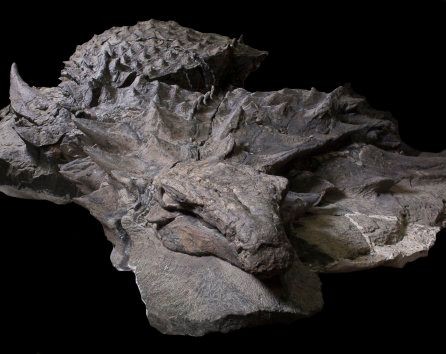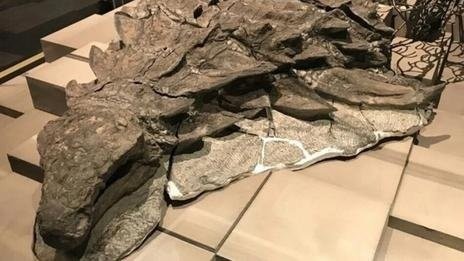A heavy equipment company began mining a strange colored stone at Millennium Mine in northern Alberta in 2011.
His supervisor quickly realized that they had something special, Michael Greshko reports for National Geographic. He stopped looking more closely and puzzled the material, which had strange patterns.

A little fossilized skin had recently been extracted from an armored nodosaur, a kind of ankylosaur. Nevertheless, this was not just a fossil; it was one of the best-preserved specimens of nodasaurus ever discovered.
The fossil remains are incredibly lifelike, resembling a sleeping dragon.

According to National Geographic, which sponsored the five-year, 7,000-hour preparation of the fossil, it’s likely that the 3,000-pound,18-foot-long creature died in or near a river. Then its bloated carcass floated out to sea before sinking back-first into the muck where fossilization began.
“It’s basically a dinosaur mummy—it really is exceptional,” Don Brinkman, director of preservation and research at the Royal Tyrrell Museum where the fossil is housed tells Craig S. Smith at The New York Times.
The remarkable preservation of its armored plates, as well as some preserved scales, are helping paleontologists finally understand the size and shape of the creature’s keratin defenses.
“I’ve been calling this one the Rosetta stone for armor,” Donald Henderson, curator of dinosaurs at the Tyrrell Museum tells Greshko.
 The nodasaurus fossil on display (Courtesy of Royal Tyrrell Museum, Drumheller, Canada)
The nodasaurus fossil on display (Courtesy of Royal Tyrrell Museum, Drumheller, Canada) The nodosaur has been described by some scientists as the “rhinoceros of its day.”
The nodosaur has been described by some scientists as the “rhinoceros of its day.”
As Matt Rehbein at CNN reports, the dino is 110 million years old, making it the oldest ever found in Alberta. It also represents a new genus and species of nodosaur. But the most exciting aspect may be at the microscopic level, Greshko reports.
The researchers have detected miniscule bits of red pigment, which could help them reconstruct the dinosaur’s coloration—a feature that may have helped it attract mates.
“This armor was clearly providing protection, but those elaborated horns on the front of its body would have been almost like a billboard,” Jakob Vinther, an animal coloration expert from the University of Bristol who has studied the fossil, tells Greshko.
The new specimen isn’t the only exceptional ankylosaur specimen recently unveiled. Just last week Brian Switek at Smithsonian.com reported that the Royal Ontario Museum discovered a new species in Montana, which they nicknamed Zuul. That specimen also has some intact armor plates and skin as well as a tail club.
Switek explains that during decomposition the armor plates of ankylosaurs typically fall off and are often washed away or not found.

But the discovery of these two extraordinary samples will go a long way towards helping researchers figure just what these animals looked like and how they used their formidable horns and armor.
The nodosaurus is now on display at the Royal Tyrrell Museum in Drumheller, Alberta, as part of an exhibit highlighting the importance of cooperation between extraction industries and paleontologists in uncovering fossils.